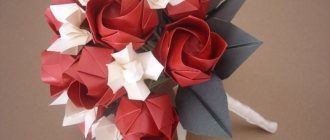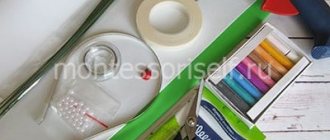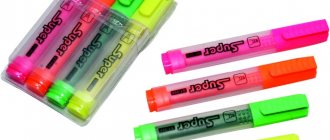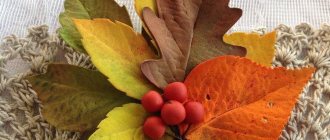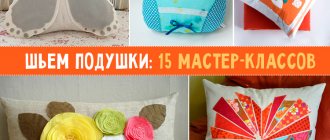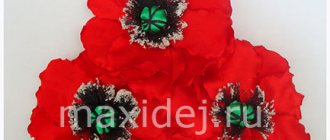Home » Decor
AccessoriesDecorDesignDIY
Alyona
22289 Views
Foamiran (as well as foam or fom) is a modern decorative material that is great for creating flowers. Working with this material is easy and pleasant, and the resulting flowers are very similar to real ones. Small flowers are used to create rings, earrings, beads and other jewelry. More details later in the article.
About the material
Foamiran is a velvety looking and touching material with a foamed structure. The polymer contains vinyl acetate and ethylene. These substances cause sheets of plastic suede to have a pungent odor while they are packaged.
The production of foamiran started in Iran. Gradually, it was adopted by entrepreneurs from China and other countries. Due to its ease of processing and variety of uses, revelur quickly became popular. Its main advantage is flexibility. The material softens and becomes ready for use under the influence of low temperature, for example, the warmth of human hands.
You can buy foam rubber at any craft store. More often you can find sheet foam, the standard size is 40 x 60 cm. The thickness of the plates varies, depending on the manufacturer, does not exceed 3 mm. Roll form is also possible. Thin sheets are sold rolled up without packaging.
The flexibility and ductility of the material increases due to the degree of foaminess. Quality determines ease of use. The more air bubbles there are in it, the easier it is to roll out and pull out different shapes after heating.
Properties and Application
Foamiran quickly became so popular due to its convenient release form, variety of colors, low price and its unique properties. It is significantly superior to fabric or paper and is suitable for creating flat crafts, three-dimensional shapes, and flowers. The decorative material has the following features:
- It becomes soft under the influence of the warmth of your hands and the flame of a candle. Greater plasticity can be achieved by attaching the element to a battery or iron;
- Keeps its shape well after cooling. Crafts become durable and do not deform when touched or dropped;
- Foam rubber can be made strong or stretched by applying various heat sources;
- Products made from foamiran can be tinted in various ways. To give a natural shade to flower petals, pastel crayons and acrylic paints are used;
- Plastic suede can be cut with ordinary scissors or a stationery knife;
- To connect several parts, use strong adhesive, a hot gun with a glue stick.
Foam is used to create various crafts, both flat and three-dimensional, decorate simple objects, and decorate interiors. You can use small flowers to cover the edge of a clock on the wall or a photo frame. If you collect rubber petals in the form of a dome, you will get an excellent lampshade for a lamp. Foamiran is also used to make fashionable jewelry, decorative dolls, gift vases, baskets with stunning bouquets of roses, peonies or assorted flowers.
Necessary tools for working with foamiran
It is easier to work with decorative foam sheets with special tools. You will also need to follow some rules and stock up on stencils and templates. To create various elements in the form of flower stems, petals, leaves, you will need the following materials and equipment:
- Colored crayons, paints. Used for tinting and adding naturalness to various prefabricated elements. Dry, oil pastels are more often used;
- Tape. The main purpose is to process stems, decorate twigs and legs. Thanks to the adhesive base, when stretched, it is perfectly fixed on wire, wooden sticks, and plastic;
- Flock powder. Using a special powder, a velvety effect is created. It is useful in the manufacture of velvety sheets and anthers on stamens;
- Heating elements. To prepare the material for work, to thin it, use an iron, candle fire, burners, and your own hands;
- Scissors. Regular stationery or tailor's cutting tools will do. Small nail scissors are useful for cutting out small details. Sometimes edge processing is carried out with figured products;
- Molds. With the help of such devices, the workpiece is given the natural texture of living plants. Realistic casts are cast from plastic, giving them a deep, rough, rough surface;
- Shaped hole punches. They will be indispensable when working with small parts. They are used to make small flowers, leaves, and various decorations;
- Bulki. They help create deep petals, like those of peony plants and bush roses. The balls are perfectly smooth and come in different sizes;
- Floral wire. This is a special wire wrapped in paper. It varies in thickness, color and length;
- Glue. To collect voluminous bouquets or create crafts from many parts, you will need strong glue and a hot gun.
Definition of terms
1.1 The following terms are used in this Privacy Policy:
1.1.1. “Site Administration” (hereinafter referred to as the Administration) - authorized employees to manage the site Online store of materials for creative work, acting on behalf of individual entrepreneur A.A. Dolzhenkov, who organize and (or) carry out the processing of personal data, and also determines the purposes of processing personal data, composition of personal data to be processed, actions (operations) performed with personal data.
1.1.2. “Personal data” - any information relating to a directly or indirectly identified or identifiable individual (subject of personal data).
1.1.3. “Processing of personal data” - any action (operation) or set of actions (operations) performed using automation tools or without the use of such means with personal data, including collection, recording, systematization, accumulation, storage, clarification (updating, changing), extraction, use, transfer (distribution, provision, access), depersonalization, blocking, deletion, destruction of personal data.
1.1.4. “Confidentiality of personal data” is a requirement for the Operator or other person who has access to personal data to comply with the requirement not to allow their distribution without the consent of the subject of personal data or the presence of another legal basis.
1.1.5. “Website Internet store of materials for creativity” is a collection of interconnected web pages located on the Internet at a unique address (URL): esel.by, as well as its subdomains.
1.1.6. “Subdomains” are pages or a set of pages located on third-level domains belonging to the website of the Internet store of materials for creativity, as well as other temporary pages, at the bottom of which the contact information of the Administration is indicated
1.1.5. “User of the site Internet store of materials for creativity” (hereinafter referred to as the User) is a person who has access to the site Internet store of materials for creativity via the Internet and uses the information, materials and products of the site Internet store of materials for creativity.
1.1.7. “Cookies” are a small piece of data sent by a web server and stored on the user’s computer, which a web client or web browser sends to the web server each time in an HTTP request when an attempt is made to open a page on the corresponding site.
1.1.8. “IP address” is a unique network address of a node on a computer network through which the User gains access to Elena Studio.
1.1.9. “Product” is a product that the User orders on the website and pays through payment systems.
An easy way to create a rose for beginners
A charming flower can be created in many ways. Beginning craftsmen can form a rose from several individual petals or prepared petal parts. The second method is simpler. The next master class will be devoted to exactly this method of collecting flowers.
To work you will need pink or red foamiran and a small green piece for the leaves. You also need a set of standard tools and several suitable paper templates. We prepare patterns for the petals - we cut out three different circles from paper, divide them into five parts, and form a rounded petal from each sector.
We apply the templates to the foamiran and outline the contours with a toothpick. Cut out one piece of each size. If desired, the edges of the petals can be tinted. Heat the iron and apply the pieces one at a time, using stretching movements to create a bulge, and curl the edges in the opposite direction.
We make a bud from several petals. Roll a ball out of food foil, put it on a toothpick and begin gluing the petals. We put the smallest petal part on a stick and glue it at the base. Now we fix the petals to the central bud in a checkerboard pattern. When one row is completed, we proceed to the next detail and proceed by analogy with the previous petals.
Peony option
If the previous method of forming a flower seemed too complicated to you, pay attention to this master class. By following the step-by-step instructions, you can create a beautiful peony rose.
Necessary materials:
- foamiran (yellow, preferably two shades, and green);
- sharp scissors;
- glue gun;
- wire;
- thick hook;
- ball on the handle;
- thick foam rubber covered with dense, lint-free material.
The first step is to prepare the petals and leaves. You can use a cardboard template, or you can immediately cut them out of foamiran. A slight difference in the shapes and sizes of the blanks will only add realism to the product. We cut out 12 of the smallest petals in the main color and 6 in another shade of yellow. If you do everything only in yellow, it’s okay.
Now you can give the blanks a natural shape. Place all the petals, except the largest ones, one by one on a heated iron. Place the hot plastic piece on the foam rubber and press it in the middle with a hook.
Heat large petals in the same way, place them on foam rubber and roll them with force into a ball. If you don’t have such a ready-made tool, you can attach a large bead to a wooden skewer or knitting needle.
Place the sepal on a toothpick and place it on the iron. The tips of the petals should curve slightly.
We evaluate the result.
Take a thin wire. Cut 4 pieces, bend a small loop at the end of each.
Glue 3 small petals onto each wire. Their edges should face the same direction.
Now glue 4 petals of the following size onto these blanks.
Form the third layer by gluing 3 more petals onto each piece.
Twist the pieces in pairs.
Twist the resulting blanks again into one common center of the flower.
Glue the bottom in a circle, first 4 darker ones, and then light petals. Next, fix the largest ones, each new petal should half cover the previous one. Lastly, attach the sepals.
To make the flower more realistic, add small bright petals to the middle of the rose using a toothpick.
If you want to achieve perfection, you can slightly tint the edges of the petals with yellow (use dry pastel or acrylic paint).
The masterpiece is ready. You can add leaves to the rose, attach a pin to it and use it as a brooch, or glue it to a hairband. The choice is yours.
How to make a hairpin with a rose from foamiran
Hair decoration can be made small, barely noticeable, or bulky, accentuated. Often hairpins are made specifically for a specific celebration. You will need to prepare scarlet foam material, golden braid, two green and light green nylon ribbons, a hair elastic, and the necessary tools.
First of all, cut out the petals according to the template. We prepare 6 large, 12 medium, 10 small. Now we glue a 14 cm long braid to a piece of 9x10 cm foil and roll the rustling material into a ball. We attach the petals one by one to the base - first the smallest ones, then the middle ones, moving them slightly one after the other. We make leaves and sepals from green foamiran. We pierce the workpiece in the center and put it on the braid. We collect two bows from ribbons, attach a flower to them and tie them with braid. We attach a hairpin or elastic band to the reverse side.
What else can be made from foamiran
Crafts made from foamiran are not only flowers. Foamiran is a universal material. You can make many unique works from it.
Postcards
A foamiran postcard will make your congratulations unique. The creation algorithm is shown in the photo:
Fruits
Fruits from foamiran will become part of the composition or a separate still life. Raspberry design scheme:
Jewelry, brooches
An original foamiran brooch is a work of art. It doesn’t require a lot of materials or time to make it. You need a ready-made foamiran flower, fastening, and glue. The blanks are arranged into a single composition. They are secured with a clasp.
Crown
A crown for a small or large princess is suitable as a festive attribute. Manufacturing scheme:
Owl
Every needlewoman can do the painstaking work of making an owl. To create a three-dimensional craft, you will need two foam balls. Details are cut out from foamiran - feathers, eyes, beak. Paste over the bird according to the photo:
Cabbage
Decorative cabbage made from foamiran is not inferior to flower arrangements in beauty and originality. Design algorithm:
Creating an interior rose on a stem
By strictly following the instructions step by step, you can make a stunning rose of any size and complexity. We will make a stable flower on a stem from foamiran, floral wire, and tape. You will also need Moment glue, a hot gun, a set of paints, and an iron to shape the leaves and petals.
You need to start working with making templates. On paper we draw blanks of the required size - large - 5 pieces, medium - 11 pieces, small - 9 pieces. We heat each one on an iron and form natural notches and bulges. Roll the foil into a ball and place it on a toothpick. We glue the petals one by one onto such a core. When the flower is completely assembled, you can give it a custom design using artistic crayons.
At the next stage, we cut out the leaves, give them the desired shape, and, if necessary, color them to match the tape. We separate 6 pieces of 10 cm each from the coil of wire and attach them to the leaves. We wrap the leaves to a piece of thick wire, thicken the trunk with tape, and paint it with paint. Finally, we fix the flower to the stem.
An interior rose will look impressive if you make it from bright foamiran. Yellow, red, blue, burgundy decor looks beautiful.
Big rose
Following these instructions we will make a large tea rose from foamiran. The diameter of the flower reaches 65 cm, the height of the stem is 1.8-2 m. Such huge flowers are used for photo shoots, decorating rooms and various festive events.
Combination of different types of flowers
In this master class, the rose should turn out to be open; it can also be made in the form of a bud, increasing the number of petals and arranging them more densely.
For production you will need:
- Three meters of plastic-metal pipe.
- Scotch.
- Four sheets of pink foamiran.
- Stapler.
- Corrugated green paper.
- Half a sheet of green foamiran.
- Cardboard.
- Green tape.
- Second glue and hot glue gun.
- Six tubes twisted from newspapers and cardboard.
Easy to do it yourself
Step by step instructions
- We take pink foamiran and bend it in half twice, then cut it into rectangles measuring 30*35 cm (we will need six pieces). We cut out the other two rectangles from another sheet. Fold the sheets in half and cut out petals from them.
- We cut the remaining sheet of foamiran into two squares measuring 30*30 cm. You need six such squares, so we cut the rest from the third sheet. From these squares we will cut out the same blanks, but smaller in size.
- We divide the fourth sheet into three parts (sides 60 cm long) so that we get rectangles 70*20 cm, with a side 70 cm. We cut out rectangles 20*26 cm from them, and then blanks of the same shape.
- We stretch the blanks by the edges, making them wavy. Stretching the largest ones, we retreat 10 cm from the bottom. We process everything this way.
Use as a decoration on clothes
Making the base
- For the base of our flower, cut out a 20*20 square from cardboard and round the edges. We make folds at the petals in their lower part, securing them with a stapler.
- On the largest blanks (first and second rows) we form three folds. For the third row we make two folds.
- We retreat five cm from the edge of the base and glue the first petals. Then we glue the second and third rows, closing the gaps.
- From the remaining material we cut out petals 12*15 cm, there should be six of them. We give them the desired shape, make one fold at a time and glue the fourth row. We do the same with the fifth row.
- We heat the workpieces on a warm iron (“silk-wool” mode). We put them in an accordion and rub them between our fingers, straighten them and give them a convex shape. We make waves on the blanks.
Stylish bouquet with pink buds
- Glue the remaining material, twisted into a funnel, into the middle. At this stage, the tea rose without a stem can be considered complete. You can make a mount at the base of the flower, glue the sepals and hang it on the wall.
- In this master class we will make a stem. We take 6-7 newspaper tubes, insert them into a plastic-metal pipe, mark the length at which the tubes fit into the pipe.
- According to the mark made, heavily coat the tubes with glue. We glue the prepared mount to the base and coat it with glue.
- We put a plastic-metal pipe on the mount and coat it well with glue. If you are going to make a removable rose, then you do not need to apply glue.
Combination of different colors
- To form a sepal, you need to take half of a leaf of green foamiran. Cut out sepal leaves from it (there should be 6-8 of them). We cut them, fold them into an accordion and then rub them with our fingers, then glue them, covering the base of the flower.
- After the sepal is ready, we begin to process the stem. To do this, take corrugated paper (to save tape). It is needed so that the stem does not show through.
- After the paper, wrap the stem with tape. The tea growth rose is ready. Use it as room decoration or for photo shoots. It is no worse than large indoor flowers and palm trees.
Bouquet in Provence style
Master class on making a rosebud
Simple and beautiful buds can be made from a minimum of materials. We will work with a foam ball by growing petals on it. Using the pattern in the shape of a drop, we cut out 8 parts, prepare an asterisk from a green piece of foam rubber for the sepal.
We fix the ball on a small piece of wire. We heat all the cut out petals and sepals with an iron. We give them the desired shape by rolling them between our fingers. We twist one petal to the middle and attach it to the base. Glue the next part unfolded, covering the twisted petal. We fix the remaining elements with an overlap, moving around the circumference. Glue the sepal and wooden skewer-stalk.
Processing rose petals
Let's start processing with triangles. Place the triangle on the heated iron.
Quickly, before it cools down, fold the material like an accordion and twist it as in the photo.
Let's straighten it out, here's what happened:
Next, we process the petals and also heat them with an iron.
We fold it like an accordion and twist it, straighten it and at the same time stretch it horizontally and vertically, giving it a boat shape (this is how we process petals a and b).
In the same way we process the petals in, d, d.
At the same time, curl the edges a little with your fingers.
Now we return to our sheets and gluing, tinting the edges with red paint.
Next, we make cuts on the sheets and gluing.
Then we heat it, twist it, straighten it and quickly apply it to the mold to give it texture.
We process the gluing in the same way: heat it, twist it, straighten it.
Peony rose: step-by-step instructions
By performing all the steps in the step-by-step description proposed in the master class, you can achieve complete compliance of such a rose with its living counterpart. To work, you will need pink or white foamiran, a piece of wire, cotton wool, oil pastels, crepe paper, and PVA glue.
On a sheet of office paper we create a diagram of future petals. You will need to draw 15 details in the form of a drop of different sizes. We cut out the required number of petals, from 3 to 15 pieces of each type, thinning them if desired.
The core is made from twisted wire. We wrap it with cotton wool dipped in glue and sprinkle it with semolina. The middle can be tinted with yellow acrylic paint. We prepare the petals, arrange them into segments and begin collecting - from large to small. Glue 4 blanks to the middle, forming a base.
We glue 5 petals at the base like a fan, bend the edges of the two outer elements and apply them to the base from the side of the two segments. You will need two such parts. Now let's start creating the main rows. We arrange the petals in 3-5 pieces and glue them to the bud. The splendor of a peony rose will depend on the number of rows.
To create a peony rose, it is better to choose thin sheets of foamiran. It is worth giving preference to materials from Iranian and Chinese manufacturers.
How to do it yourself?
It is better to create flowers from foamiran with your own hands using a master class.
For example, it could be an interior floor tea rose, the diameter of which is about 65 centimeters and the height reaches 180-200 centimeters. The finished decoration is suitable both for photo shoots and decorating the hall for the holiday, and simply for enlivening the interior.
It is also necessary to add that if you attach the petals closer to each other, then the open tea rose is transformed into a closed version.
To form a flower you will need 0.5 standard green foamiran sheets and 4 pink sheets. The stem is formed on the basis of a three-meter metal-plastic pipe, as well as 6-7 newspaper or cardboard tubes.
The work will be impossible without instant glue and a gun, green tape, adhesive tape, green corrugated paper, a stapler and cardboard.
First of all, a standard layer of pink foamiran is folded in half twice and cut into 4 squares. It is necessary that the sides of the resulting blanks be equal to 30 and 35 centimeters. In total, you need 6 such squares, and therefore 2 more will have to be cut from another sheet.
Blanks with sides of 30 and 35 centimeters are folded in half and used to cut out petals.
From the remains of the second pink sheet, 5 centimeters are cut off, after which the workpiece is cut in half. If everything is done correctly, then 2 more squares with sides of 30 centimeters each should form.
A total of 6 copies are needed, and therefore we cut out 4 more from the third pink sheet. Petals are again cut out from the resulting blanks, the size of which should be 5 centimeters smaller than the previous ones. The fourth sheet of foamiran is divided into three parts so that rectangles with sides of 20 and 70 centimeters are formed. Measuring from a side of 70 centimeters twice 26 centimeters each, we get 6 rectangles with sides of 20 and 26 centimeters. Tea rose petals should be cut out of them again.
At the next stage, the edges of the petals need to be stretched, making them wavy. From a piece of cardboard with sides of 20 centimeters, cut out the base of a life-size flower. We round the edges of the part.
The bud is formed by fastening individual petals with glue or a stapler, with preliminary formation of folds. The parts are glued in a circle, slightly overlapping, and the components of different rows should be staggered. From the remains of pink foamiran we cut out the petals for the core of the tea rose.
To form the base of a growth flower, it is necessary to twist newspaper and paper tubes, which are glued with rays to the cardboard base, forming the basis for a metal-plastic tube. Using green foamiran, corrugated paper and tape, the trunk of the plant is formed.
Master class on making large roses from foamiran in the video below.
Japanese style rose
It’s easier to make such a rose from marshmallow foamiran. You will need to stock up on several lilac or blue leaves, 1 mm thick. For decoration you will need blue oil pastel, a piece of cotton wool or a sponge. Making any flower from foam rubber begins with a pattern. We will collect Japanese roses from 3 types of petals. It is better to make blanks with a reserve, since marshmallow foam is porous and breaks easily.
The main difference between a flower in an oriental style is its unusual coloring. The color gains brightness from the middle to the edges of the petals. When all the blanks are cut out, we tint them with the same pencils and shade them with a sponge. Now let's start heating and forming the structure. We lean each element against the iron for 2-3 seconds, fold it like an accordion, and twist it.
First glue the small petals onto the foil core, then the medium ones, and finally the largest ones. We cut off the excess at the bottom. The last element is to close the base.
Dispute Resolution
8.1. Before filing a claim in court regarding disputes arising from the relationship between the User and the Administration, it is mandatory to submit a claim (a written proposal or an electronic proposal for a voluntary settlement of the dispute).
8.2. The recipient of the claim, within 30 calendar days from the date of receipt of the claim, notifies the claimant in writing or electronically of the results of consideration of the claim.
8.3. If an agreement is not reached, the dispute will be referred to the Arbitration Court of Vitebsk.
8.4. The current legislation of the Russian Federation applies to this Privacy Policy and the relationship between the User and the Administration.
Wreath of small roses
Miniature roses can be assembled into a composition and placed in a vase or pot, placed on the rim in the form of an original wreath. The work is expected to be simple, but painstaking. You will need to prepare foamiran of a suitable color for the buds and leaves, thin wire, tape, adhesives, nail scissors or a figured hole punch.
We cut out the blank petals and tint them if desired. After heat treatment, we give them the desired realistic shape and use molds for the leaves. We divide the wire into several equal parts, attach a foil base to the end of each and collect the petals into closed roses, attaching the leaves. In this way we make 10-15 blanks on wire legs. The quantity depends on the rim collection pattern. We attach the blanks to the thick wire and wrap them with tape.
How and with what to tint rose petals from foamiran
Thanks to its special structure, the paint in the foam is perfectly absorbed, filling the pores. The painted product does not stain hands and clothes and can be dry cleaned and washed. Foamiran petals are tinted with the following types of paints:
- Dry pastel. Run chalk over a damp cloth and transfer it to the product. For long-lasting and bright coloring, movements are made with slight pressure. With light shading, the movements are sliding.
- Oil pastel. You can transfer color through a napkin or simply by drawing the necessary contours. For faster penetration of paints, foamiran can be wetted.
- Acrylic paint. Apply it to craft blanks with a brush or cotton swab. The edges of the petals and leaves are tinted using blotting movements.
Methods and terms for processing personal information
5.1. The processing of the User's personal data is carried out without a time limit, in any legal way, including in personal data information systems using automation tools or without the use of such tools.
5.3. The User's personal data may be transferred to authorized government bodies of the Russian Federation only on the grounds and in the manner established by the legislation of the Russian Federation.
5.4. In the event of loss or disclosure of personal data, the Administration has the right not to inform the User about the loss or disclosure of personal data.
5.5. The Administration takes the necessary organizational and technical measures to protect the User’s personal information from unauthorized or accidental access, destruction, modification, blocking, copying, distribution, as well as from other unlawful actions of third parties.
5.6. The Administration, together with the User, takes all necessary measures to prevent losses or other negative consequences caused by the loss or disclosure of the User’s personal data.
How to care for foamiran products
Roses made of foam rubber, like other crafts, are not afraid of sunlight and moisture. Products made from foamiran can be placed on the windowsill, in the bathroom, in the kitchen. But, despite their resistance to heat and humidity, crafts require careful handling and some care.
Flowers made of several layers and many petals are best protected from dust and stored in a plastic or cardboard box suitable for the size of the craft. Dirt in hard-to-reach places should be carefully removed with a small brush. Dust is blown off a large composition using a hairdryer.
DIY fabric roses
Such work in the form of a rose does not have to be done only from fabric; it can even be done from paper or leather and leather substitutes. Roses and headbands made of satin ribbons look especially beautiful; they add a unique shine and prominence to the work. You can also make several multi-colored items and collect them in a bouquet or make a beautiful decoration for your bow.
Elegant and realistic fabric rose
Thus, making a rose in the form of a spiral or any other flower from foamiran is quite easy even for an inexperienced craftsman. Making such decorative items can not only increase the experience of the needlewoman, but also give sophistication and originality to things like a pillow, photo frame or gift that will be decorated with this flower. Both professionals in sewing decorative items and absolute beginners in this business can cope with this.
